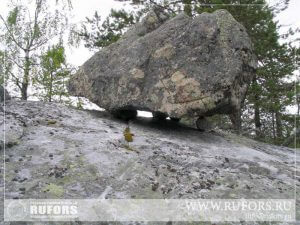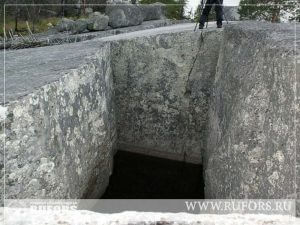
Abaddon
 26. 04. 2024
26. 04. 2024



 4
4
 29. 12. 2016
29. 12. 2016

In December 2008, the Russian Ufological Research Station RUFORS made an expedition to the Kola Peninsula. Its basic task was to find traces of the legendary Hyperborea, which, as scientists have cautiously said in recent years, became the place where Russian nationality came from, and which fundamentally influenced the development, science and culture of other countries…
Hyperborea Valerije Demina
Doctor of Philosophy Valery Nikitich Demin repeated the march of Alexander Barchenko after almost sixty years. During the Hyperborea-97 and Hyperborea-98 expeditions, researchers found a number of clues that indicated that there was an advanced civilization in these places in ancient times.
"We have discovered several pyramids that resemble mounds, and these also need to be explored by georadar," said Valery Demin after the expedition. "Among them are those that look as if they have been cut off at the top with a knife, leaving only an absolutely flat surface. We also found the remains of the foundations of houses, geometrically regular blocks, inverted columns… It is evident that there used to be massive stone buildings everywhere in the north. In general, the northern coast of the polar seas, from the Kola Peninsula to Chukotka, is rich in pyramidal columns composed of stones called "gurije". Their appearance is reminiscent of the Lapland meetings, the iconic stone buildings that the Sámi have long worshiped. They are believed to have been built in visible places like lighthouses so that they could be well-versed in the landscape. Examination of the fragments from the stone blocks showed that they are of technical origin and originated about ten thousand years BC. "
Magic of stones, traces of great civilization
The myths of the indigenous population of the Kola Peninsula are closely connected with the cult of Lappish meetings. It is interesting that the Sami themselves  they do not call the tundra anything other than the "City of Flying Stones." This is where the worship or worship of the huge stone megaliths comes, which seem to be specially built on three small stone "legs" and are called Sejdy. Sledge, translated from Lapland, means shrine, holy, sacred. When you look at these huge statues, it seems as if these huge boulders are literally hovering above the ground. These stones also gave the name to the Sámi lake - Sejdozeru or Seďjavvr, where "sejd" means a holy and "javvr" lake, a lake reservoir, together a sacred lake. Virtually any such stone block can weigh several tens of tons, and it is remarkable that they were very elegantly and literally erected on three supports with jewelery precision. But by whom? And when? With what help could people of ancient times move and eventually lift these huge heavy megaliths? There are still no answers to these questions.
they do not call the tundra anything other than the "City of Flying Stones." This is where the worship or worship of the huge stone megaliths comes, which seem to be specially built on three small stone "legs" and are called Sejdy. Sledge, translated from Lapland, means shrine, holy, sacred. When you look at these huge statues, it seems as if these huge boulders are literally hovering above the ground. These stones also gave the name to the Sámi lake - Sejdozeru or Seďjavvr, where "sejd" means a holy and "javvr" lake, a lake reservoir, together a sacred lake. Virtually any such stone block can weigh several tens of tons, and it is remarkable that they were very elegantly and literally erected on three supports with jewelery precision. But by whom? And when? With what help could people of ancient times move and eventually lift these huge heavy megaliths? There are still no answers to these questions.
By the way, if we compare the weight of the megalithic sedges and the weight of the stone blocks of the Egyptian pyramids in Giza, then the average data obtained by the RUFORS group show that their weight is approximately the same. And as for the technology of their construction here on the Kola Peninsula, its complexity does not lag behind the technology of building Egyptian pyramids.
Perhaps the name of the place, which reads "City of Flying Stones", hides the key to the phenomenon of building gigantic buildings from massive stone blocks. Our ancestors had technology that allowed them to move large loads without the use of special tools by literally forcing them to fly through the air.
At the same time, the secret of this technology is the insider's known today. Edward Leedskalnin was Latvia, who emigrated to the USA in the 1920s  last century, and he managed to unravel this secret. In a few decades, he created a complex of huge sculptures and megaliths with a total weight of about eleven hundred tons, all by hand, without the use of machines. This remarkable building was named the Coral Castle, and engineers and builders are still struggling to solve its construction process. To all the questions, Ed proudly replied, "I have revealed the secrets of the pyramid builders!" The few witnesses who managed to follow Edward's work said that he sang to his stones, and they then lost weight. After he died, fragments of records were found in his study, located in a square tower, talking about the Earth's magnetism and "controlling the currents of cosmic energy."
last century, and he managed to unravel this secret. In a few decades, he created a complex of huge sculptures and megaliths with a total weight of about eleven hundred tons, all by hand, without the use of machines. This remarkable building was named the Coral Castle, and engineers and builders are still struggling to solve its construction process. To all the questions, Ed proudly replied, "I have revealed the secrets of the pyramid builders!" The few witnesses who managed to follow Edward's work said that he sang to his stones, and they then lost weight. After he died, fragments of records were found in his study, located in a square tower, talking about the Earth's magnetism and "controlling the currents of cosmic energy."
But was this the secret of the Egyptian clergy? In their annals, the ancient Egyptian tradition preserved the testimony of the "palaces of the gods" who, in the "first period of history, before their destruction by the great flood, lived somewhere in the north of our planet." Egyptian culture seems to have absorbed the knowledge of Hyperborean civilization, which was forced to leave its cities by the action of completely natural forces, which in fact began the great migration of nations. An excellent French intellectual of the 20th century, founder of the School of Esoteric Traditionalism, philosopher and mathematician René Genon (who became an Egyptian citizen and adopted the name Sheikh Abdul Wahid Yahya), argued that "the Egyptian Heliopolis was only a reflection, a substitute for . "